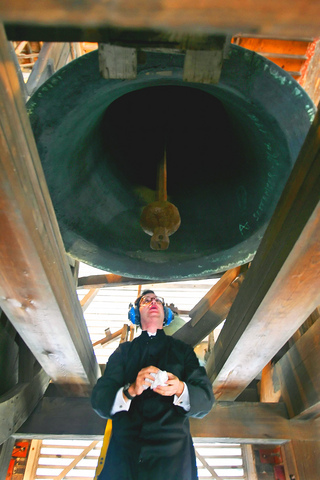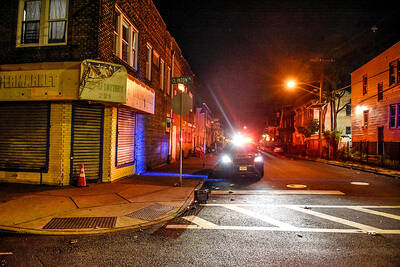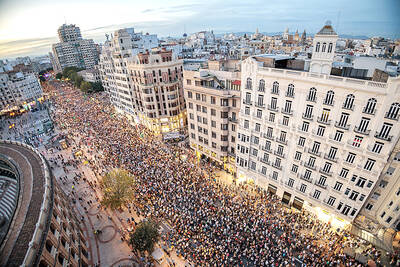For the first time since Hurricane Katrina hit, the brass bell tolled on Sunday at St. Patrick's Church to welcome to Mass a handful of worshippers, mostly rescue workers and police officers.
"You can call this a homecoming bell for New Orleans," Robert Ramirez said as he rang the huge bell just before 8am at the church on Camp Street, near the French Quarter. "We have good news we want to get out. We are trying to get up and running. The whole thing is starting to come together."
Despite the sparse attendance, Mass at St. Patrick's was among the signs that life was returning to near normality in some areas of New Orleans. Thousands of residents who had fled Hurricane Katrina began returning to the area this weekend, most of them to homes relatively unscathed.

PHOTO: NY TIMES
At St. Louis Cathedral in the heart of the French Quarter, Archbishop Alfred Hughes celebrated Mass for the first time since the storm hit more than a month ago. The overflowing crowd included hundreds of local worshipers as well as police officers, members of the National Guard and dozens of other rescue workers.
"We in New Orleans are a people of faith," Hughes said. "What if this tragedy should push ourselves to a greater good?"
News cameras crowded around the church, annoying some of the residents who had come seeking solace. A sign that prohibited taking photographs during Mass was ignored for the day.
"I just want to hear the word and go home," said Larry Bastian, 38, who had moved to a new apartment after his home in New Orleans East was destroyed. "I have a job here, but no family, no friends. They are all gone. So here I am, tired and lonely."
At St. Patrick's, parishioners embraced, relieved to see friends they had not heard from in weeks. They exchanged stories of traveling to safety and returning to varying degrees of destruction. They all wondered if the church they loved would ever have as many worshippers as it did before the hurricane.
"All of September, we missed all of September," said Kathy Jordan, 57, shaking her head as she thought about the last time she attended Mass at St. Patrick's. Her home in Belle Chasse had some roof damage, and the homes of her nieces and sisters were destroyed.
"Even now, nobody knows what they are going to do," she said. "We just get back and try to start all over."
A revised city re-entry plan allowed some 200,000 residents to return to several parts of the city late last week and more came back to homes in the surrounding areas. And as the highway exits opened, supermarkets restocked their shelves and restaurants began serving food, homeowners began making their way home.
There is now way to know just how many of the residents returned. But if the weekend was any guide, residents seem likely to return in a slow trickle, not a surging wave.
Checkpoints were not choked with traffic, though a steady stream of traffic continued on highways and several city streets. Several residents were simply looking at their homes and looking at the city in the rearview mirror, returning to wherever they had found a place to stay. Others were determined to settle in, even with undrinkable water and spotty electricity.
"It's messy, real messy," said Althea Williams, who returned on Saturday to her home with major roof damage after staying with family in North Carolina for nearly a month. "And if you can't drink the water, I'm not going to bathe in it. But I have to be here. I have a job here and a life here."
Others wondered if they would stick to their plans to stay.
On the Sunday before Hurricane Katrina hit, Ann Moll and her husband, Ed, headed to Baton Rouge. Moll could easily list the things she missed about New Orleans: elaborate Sunday brunches, late afternoon sips of vodka and the traditional Mass at St. Patrick's topped the list.

DOUBLE-MURDER CASE: The officer told the dispatcher he would check the locations of the callers, but instead headed to a pizzeria, remaining there for about an hour A New Jersey officer has been charged with misconduct after prosecutors said he did not quickly respond to and properly investigate reports of a shooting that turned out to be a double murder, instead allegedly stopping at an ATM and pizzeria. Franklin Township Police Sergeant Kevin Bollaro was the on-duty officer on the evening of Aug. 1, when police received 911 calls reporting gunshots and screaming in Pittstown, about 96km from Manhattan in central New Jersey, Hunterdon County Prosecutor Renee Robeson’s office said. However, rather than responding immediately, prosecutors said GPS data and surveillance video showed Bollaro drove about 3km

Tens of thousands of people on Saturday took to the streets of Spain’s eastern city of Valencia to mark the first anniversary of floods that killed 229 people and to denounce the handling of the disaster. Demonstrators, many carrying photos of the victims, called on regional government head Carlos Mazon to resign over what they said was the slow response to one of Europe’s deadliest natural disasters in decades. “People are still really angry,” said Rosa Cerros, a 42-year-old government worker who took part with her husband and two young daughters. “Why weren’t people evacuated? Its incomprehensible,” she said. Mazon’s

‘MOTHER’ OF THAILAND: In her glamorous heyday in the 1960s, former Thai queen Sirikit mingled with US presidents and superstars such as Elvis Presley The year-long funeral ceremony of former Thai queen Sirikit started yesterday, with grieving royalists set to salute the procession bringing her body to lie in state at Bangkok’s Grand Palace. Members of the royal family are venerated in Thailand, treated by many as semi-divine figures, and lavished with glowing media coverage and gold-adorned portraits hanging in public spaces and private homes nationwide. Sirikit, the mother of Thai King Vajiralongkorn and widow of the nation’s longest-reigning monarch, died late on Friday at the age of 93. Black-and-white tributes to the royal matriarch are being beamed onto towering digital advertizing billboards, on

POWER ABUSE WORRY: Some people warned that the broad language of the treaty could lead to overreach by authorities and enable the repression of government critics Countries signed their first UN treaty targeting cybercrime in Hanoi yesterday, despite opposition from an unlikely band of tech companies and rights groups warning of expanded state surveillance. The new global legal framework aims to bolster international cooperation to fight digital crimes, from child pornography to transnational cyberscams and money laundering. More than 60 countries signed the declaration, which means it would go into force once ratified by those states. UN Secretary-General Antonio Guterres described the signing as an “important milestone,” and that it was “only the beginning.” “Every day, sophisticated scams destroy families, steal migrants and drain billions of dollars from our economy...